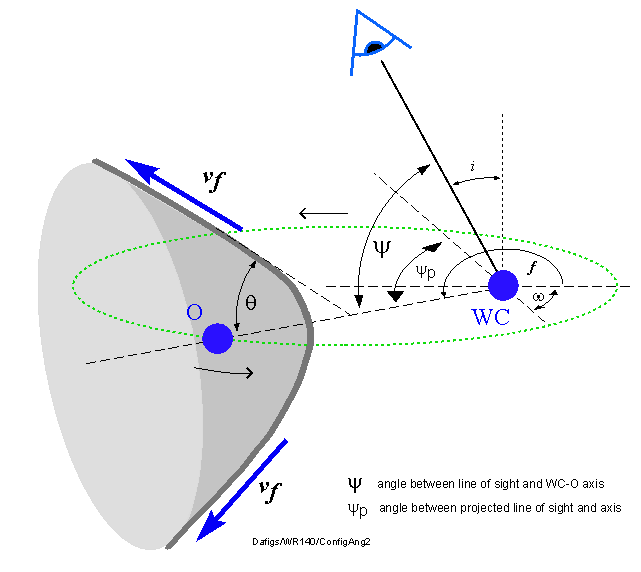| Colliding-wind binaries |
| WR140 radio variation |
| X-MEGA Campaign |
| Episodic dust-makers |
| WR140 orbital motion |
| VdS WR140 campaign |
| WR140 Introduction |
| Co-ordinates J2000 |
| R.A. 20 20
27.98 Dec. +43 51 16.3 V = 6.87; v = 7.07 |
Orbital and wind phenomena at critical phases in 2008-09
| phase | Year | Date | Orbital phenomenon | f | r/a | RV/K | P.A. | pos | ψp | ψ | RVf1 | RVf2 |
| 0.947 | 2008.61 | Aug 12 | conjunction: WC star behind | 223 | 0.62 | 0.00 | 83 | E | 0 | 32 | -1780 | -1275 |
| 0.996 | 2009.00 | Jan 0 | quadrature | 314 | 0.14 | +1.00 | 353 | N | 90 | 90 | -40 | -30 |
| 0.000 | 2009.03 | Jan 12 | periastron passage | 0 | 0.12 | +0.69 | 323 | NW | 137 | 128 | +1190 | +930 |
| 0.004 | 2009.07 | Jan 24 | conjunction: O star behind | 44 | 0.14 | 0.00 | 262 | W | 180 | 148 | +1780 | +1275 |
| 0.046 | 2009.40 | May 26 | quadrature | 133 | 0.57 | -1.00 | 173 | S | 270 | 90 | +30 | +22 |
Observing campaign
The next periastron passage is in January 2009 and the system will be very active from about August 2008 to May 2009. There are plans to observe WR 140 intensively with many instruments in this period: some X-ray observing time has already been awarded and other programmes have started. But WR 140 will be varying so quickly in this period that more observers will be welcome. Fortunately, WR 140 is sufficiently bright to be accessible to many moderate-sized telescopes. Here are some ideas:
-
Optical spectroscopy to help refine the RV orbit. As can be seen from the table, the velocity changes very rapidly in the second half of 2008 (K(O) = 30 km/s, K(WR) = 82 km/s) and in the first few months of 2009, so frequent - daily - observations are needed to tie down the orbit tightly enough to model the system and all the other phenomena.
-
High-resolution spectroscopy of emission-line profiles to measure the velocity of the compressed wind in the interaction area (blue arrows in the figure), most easily observed as sub-peaks on top of the flat-topped profiles of low-excitation lines like C III at 5696Å [2] or He I at 10830Å [4]. As can be seen from the last column of the table, the range of velocity is enormous. The exact values depend on the geometry of the interaction region.
-
Infrared observation of dust emission. The near-IR flux is expected to rise from quiescence (e.g. K = 5.12) in early January to maximum (K = 3.45) around March 11. The speed of this rise means that it has not been well defined, and frequent observations are needed to define it and the shape of the near-infrared maximum. At longer longer wavelengths, the amplitudes are greater, and the maxima occur later.
-
Optical photometry to observe line-of-sight dust. Some of the dust formed by WR 140 will lie in our line of sight, causing small eclipses in the optical. The colours of the eclipses give information on the dust grain sizes [2], and frequent, multi-colour optical monitoring from December to May would be valuable.
See also the VdS Spectroscopy Sections's WR 140 campaign pages.

Peredur Williams
[Home page]
[2] S.V Marchenko et al. ApJ 596, 1295, 2003.
[3] S.M. Dougherty et al. ApJ 623, 447, 2005.
[4] W.P. Varricatt et al. MNRAS 351, 1307, 2004